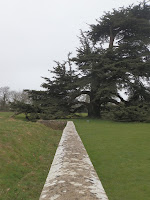Firstly because the wall seen from the garden is very small, it doesn't impede the view so it allowed the owners to 'borrow the landscape'. Secondly, the ditch stopped any cattle or sheep from getting from the landscape/fields that you're borrowing in your view from getting into the garden. Thirdly, it can function as a boundary.
The term seems to have come across from the French language as a term of surprise - perhaps one of the politer phrases used if they first found the ha-ha when upside down in the dry ditch!
The word ha-ha it seems, according to the Oxford English Dictionary, was first seen in England in 1712 as 'Ah Ah' in 'The theory and practice of gardening' by Antoine-Joseph Dézallier d'Argenville and translated by John James. The book talked about having a terrace which was terminated by having an Ah Ah with a dry ditch at the foot of it. The term had various revisions, for instance 'Haw Haw' as used by Daniel Defoe in his 'Defoe's Tour of Great Britain' in 1748 and 'Ha-hahs' used in the book 'Gardening' by Amherst.
 |
| The ha-ha seen looking out over the boundary from the garden. |


Ah, that's interesting! Thanks for the explanation ;)
ReplyDeletelol no problem. I'm glad you liked it :D
Delete